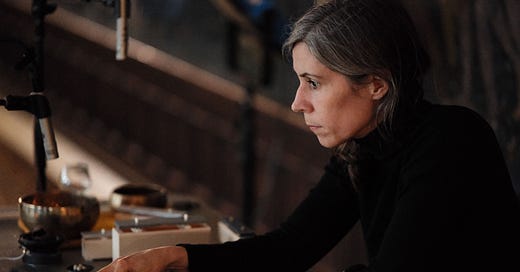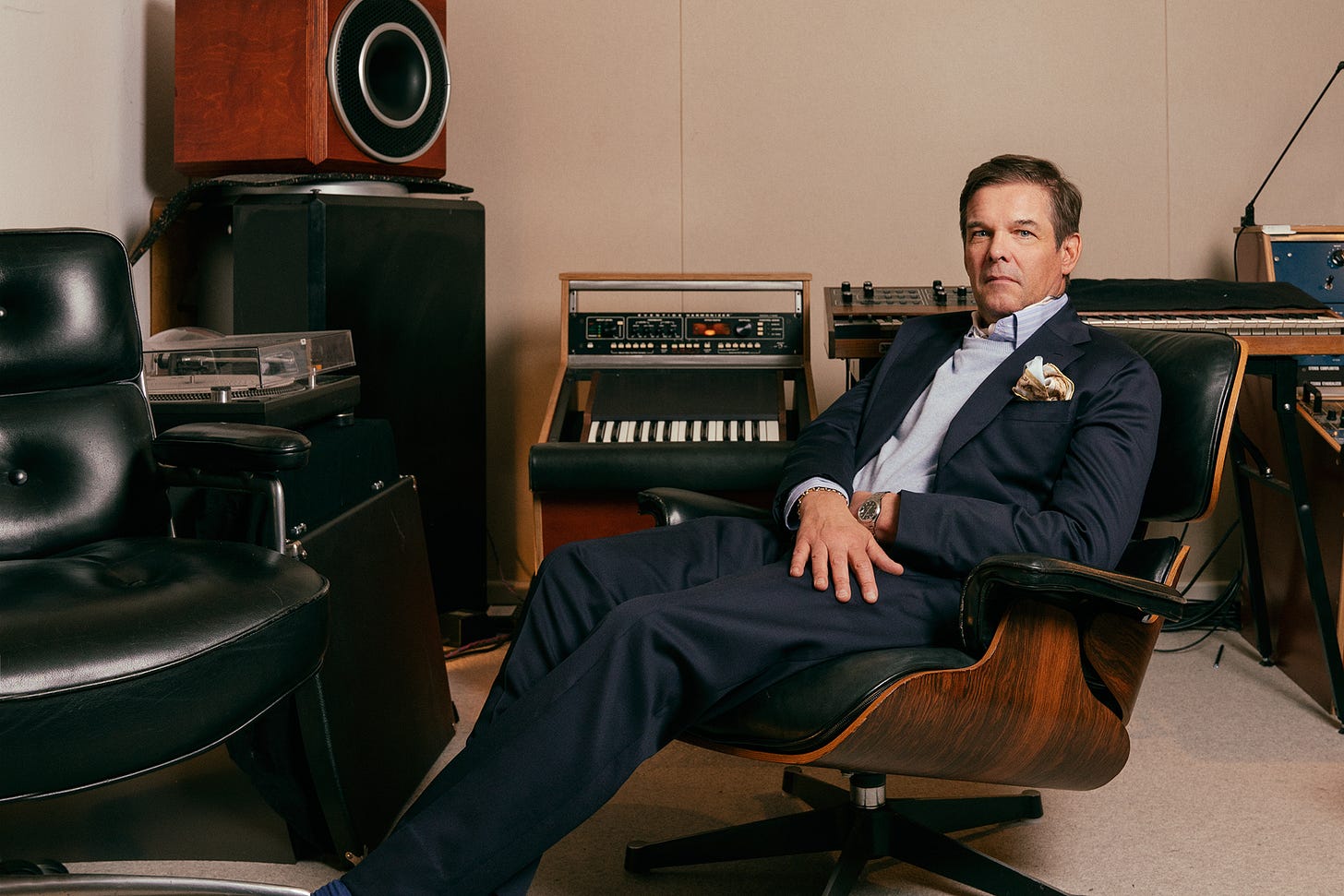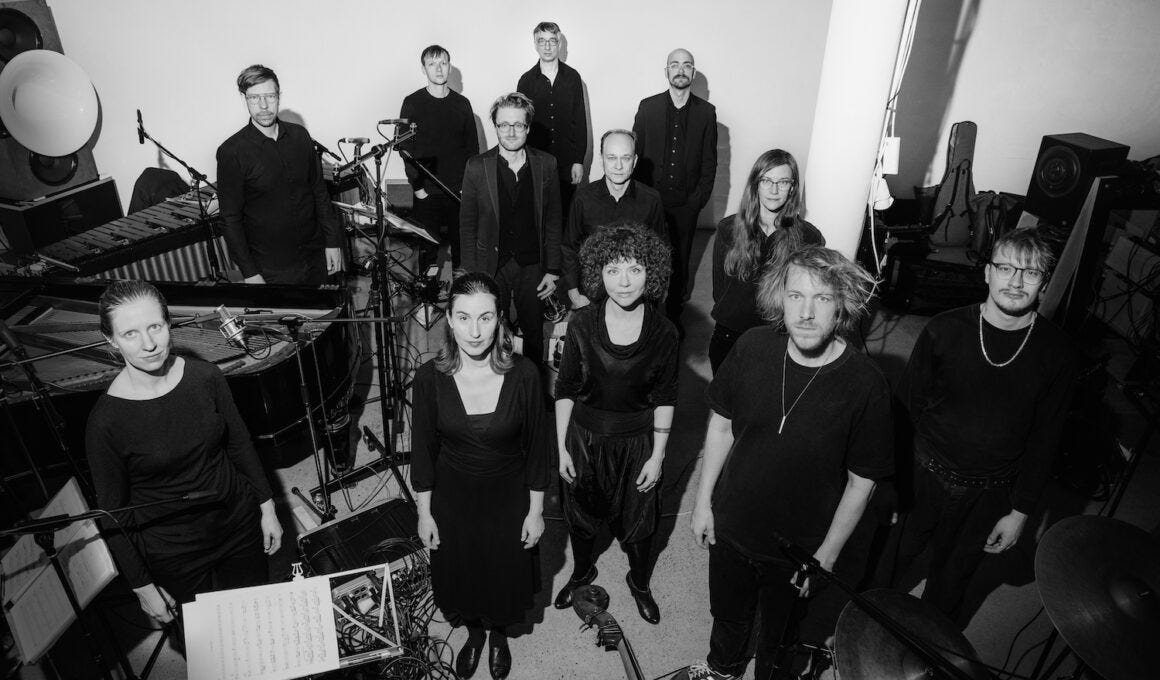Going Long as Days Grow Shorter
Marja Ahti, Moritz von Oswald, Dave Rempis & gabby fluke-mogul, Stefan Schultze Large Ensemble, Juçara Marçal and Cadu Tenório
No Meandering: Marja Ahti’s Meticulous Constructions
There was a period about 15 years ago when the widespread affordability of digital video cameras seemed to convince way too many people that they could make movies. This realization came to me as I endured a spate of music documentaries, where uber fans felt the need to shower adulation and capture the most quotidian, numbing details about the life and work of their heroes. I was part of the zine era, where I fully embraced DIY culture and methodology, but I never got assignments to review other zines during my days at the Chicago Reader, but I did have to review a lot of music docs, whether they were screening at local art theaters or film festivals. I soon disliked the technology for encouraging folks who had zero knowledge of filmmaking but loved insert second or third tier musician so much that they had to make a documentary. In some cases the fledgling filmmaker seemed more interested in getting hang time with their hero(es) more than making a watchable film.
I’ve been feeling that way about technology again, of late, in regard to ambient music, where cheap, user-friendly electronics have afforded just about anyone with a mouse pad to call themselves a composer. I love that such technology can make anyone’s ideas come to life, but the fact is most people simply don’t possess the ideas, discipline, or talent to make something worth listening to. There’s been such an explosion of people making long-form soundscapes with admixtures of field recordings, synthesizers, and samples, assembling disparate elements with a directionless drift that silence has never seemed more profound or desirable. I’ve become especially picky about this type of work, but my attraction to Tender Membranes (Black Truffle), the latest album by Finnish musician Marja Ahti, just kept growing, increasing my desire to get lost in the sounds in a growing number of contexts—whether absorbed in the music while listening on headphones on the train, or letting it wash over me as I’ve started drifting to sleep at night. I was reminded that I actually adore this stuff when it’s done well. Ahti is a master.
I’ve been admiring her work since first catching a performance at MaerzMusik in March of 2019, but after going back to some of her earlier recordings there’s little doubt that Tender Membranes pushes the old tropes into new terrain, where Ahti demonstrates a much sharpened command of those sounds and how to assemble them. I vividly remember the use of prayer bowls in that performance, and they’ve become staples in her work, opening “Shrine (Aether)” with a patiently enveloping strike that resonates so leisurely that I’m quite certain it’s extended electronically. That sound is eventually joined by a sustained, rising electronic tone until both are abruptly cut off, replaced by what sounds like a coastal field recording. There’s no clear narrative at work and Ahti’s excellence in blending field recordings with electronics reminds me of Olivia Block’s genius for blurring the lines between synthetic and organic representations of certain sounds.
As you can hear below, the piece moves deftly between these realms, sometimes with hard cuts, sometimes with meticulously constructed accretion, all of which comes in stunning shifts in density and activity. Ahti usually dispatches with slick transitions, letting us experience sudden changes in all of their head-snapping surprise and dynamic splendor. I hear sizzling electronics, buzzing insects, rainfall, aquatic gestures, synthetic chiming, and so much more, arriving in single layers and crystalline collisions. As much as Ahti retains plenty of contextual mystery, the clarity of her sounds is always indisputable.
The rest of the album is no less riveting, a deft, constant juggling act of texture and color, in viscerally fluctuating combinations. Ahti doesn’t try to obfuscate her source material, but its provenance doesn’t seem so important either—it’s what the sounds do, how they feel, and the sequence in which they are assembled that proves deeply compelling and moving, constructed with the sculptural finesse of a film auteur—not to be confused with a novice music documentarian. While it’s a cliché to recycle phrases like cinema for the ears or some other trite bromide, Ahti really does operate on a cinematic scale.
Moritz von Oswald’s Harrowing Dip into Choral Music
I can’t imagine that there’s anyone who might think I have any real knowledge of club-derived electronic music, but there have been certain artists whose ideas have so consistently evolved, pushing well outside of the dance world that I make an effort to keep up. I can’t even say to have a solid grip on the music of Berlin producer Moritz von Oswald, but over the decades a lot of his music has pulled me back in, further impressed by the rigor, curiosity, and change involved. On Thursday, November 16 he’ll present music from his elegant new album Silencio (Tressor), a special concert blending his sophisticated electronics with a classical vocal choir at St. Thomas Kirche.
For the new album he wrote a number of minimal works rippled with fine-tuned transformations, spatial depth, and weird tunings. The music is clearly rooted in the club world, however more faint that connection grows in von Oswald’s music, but there’s a devoted attention to the finest gradations of sound itself that makes him feel vaguely akin to certain segments of the contemporary music scene in Berlin. He enlisted Finnish composer Jarkko Riihimäki to transcribe these spartan pieces for the 16-member Vocalconsort Berlin. On the piece “Luminoso” the harmonic quality suggests early music, but the harrowing columns of wordless singing sound totally modern in their brutalist starkness. They are steeped in a kind of microtonal splendor, all shadowed by a faint, humming electronic halo. A track like “Infinito” plays with smaller parts, a sustained balance between what sounds like a single voice and a shimmering, thin-toned drone, with sporadic bloops and bleeps drifting by like space junk. It’s almost like a study of the larger action in “Luminoso.” “Colpa” feels less murky, its clearer vocal lines pummeled by occasional low-end tones that sound like a deeply resonant gong.
Despite the voices being based on transcriptions of the electronic tracks, neither element feels imitative. We can definitely detect the difference, even if sub frequencies and other effects blur the lines between them. On top of all of this are additional layers of detail that could easily pass us by—a kind of pressure-valve release of puffy steam, splintered organ-like tattoos, and even submerged beats! The producer enfolded different elements of the vocal recordings into his electronic tracks, so I’m not sure how it will unfold live, but this is that rare breed of collision that’s both tantalizing and stands a good chance of succeeding given von Oswald’s rigor.
Dave Rempis and gabby fluke-mogul Come Together for a Night of Solo and Duo music
The next Nowhere Street concert happens this Thursday, November 16 at KM28, with saxophonist Dave Rempis and violinist gabby fluke-mogul. The sublime Chicago reedist has played there series before, playing with the gut-punching collective Kuzu—with drummer Tyler Damon and guitarist Tashi Dorji—and last year returning with an elastic trio with pianist Elisabeth Harnik and drummer Michael Zerang. Over a long career Rempis has held down a variety of long-running projects that also includes the Rempis Percussion Quartet, Ballister, and his muscular trio with bassist Joshua Abrams and drummer Avreeayl Ra, which is frequently appended by pianist and ARP synthesizer whiz Jim Baker. But Rempis is a social musician, who also thrives in more ad hoc settings. He’s a committed improviser, and since the demise of the Vandermark 5 in 2010—Rempis joined in 1999—I can’t readily think of a context where he’s played written parts (although I’ve seen him to do it exceedingly well in the past). Even in his longest running projects, it’s all about free improvising.
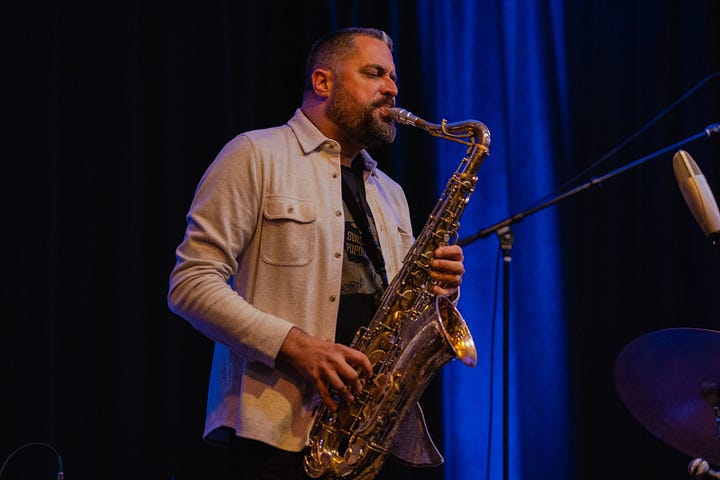
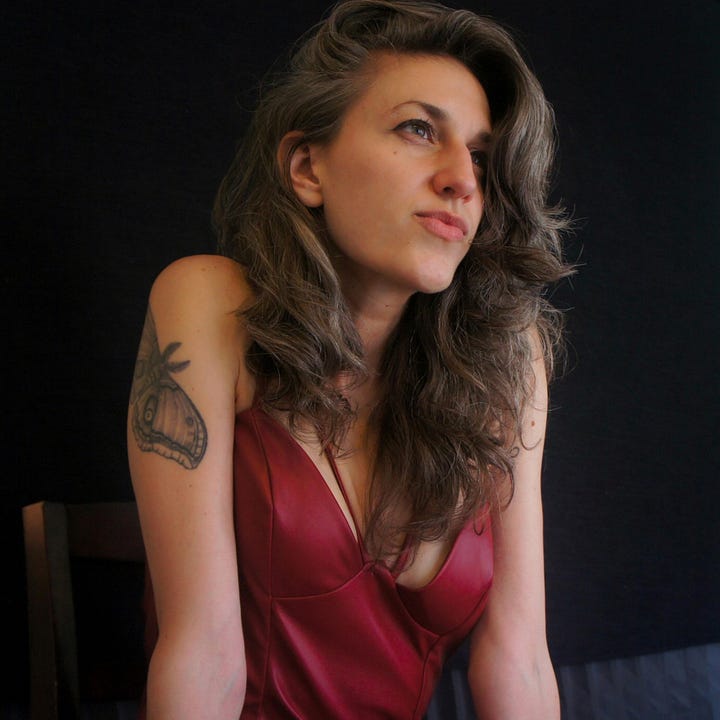
He recently released On the Blink (Aerophonic), a dynamic trio album with Belgian electric bassist Farida Amadou and Belgian pianist Jonas Cambien—who’s been based in Norway for nearly a decade. They both use electronics as well. With most improvised albums you might have a sense of what you’ll hear, but I had no idea what to expect with this one. Amadou is a ferocious musician who’s a true student of overdriven sounds awash in rumbling distortion, tightly controlled feedback, and tough resonance, but I have never heard her manipulate pure sound so much and with such effectiveness. She unleashes gnarly electric bass patterns, grooves, and guitar-like squalls along the way, but Amadou functions like a sound painter. It turns out that she already had a strong musical relationship with Cambien, who moves between cluster-laden spasms and extended lines of fractured lyric beauty (often subtly curdled by some electronic element). Much of the electronics are either enhanced or driven by their main instruments, but sometimes I can’t tell who’s doing what. In a way it becomes a fascinating collision with the solitary Rempis coming face-to-face with a duo that has clearly forged its own identity beforehand.
Luckily, that encounter never reveals any imbalance, and it’s clear that the saxophonist has developed and tweaked his own procedures in this group, improvised though they may be. Below you can check out the opening track “Exotropia,” which illustrates some of these ideas, but in no way indicates the rich variety the trio achieves across the album, often a tough prospect in free improvisation. The epic “Radiata” goes through countless disparate episodes, a seamless flow of conflict settled in the most creative of ways. That allows the saxophonist to unleash scarred abstractions or fleet bebop lines, and have them both sound utterly simpatico.
Violinist gabby fluke-mogul seems cut from a similar cloth, because in the three years since they surfaced on the New York scene their work has turned up in a rapidly expanding array of contexts, whether the stunning solo work on last year’s Love Songs (Relative Pitch) or a series of duos including a powerful pairing with violist Joanna Mattrey and another with bassist Amanda Irarrázabal. They sound no less assured in the absence of a harmonic foil, revealing impressive malleability in the presence of percussionist Nava Dunkleman on the recent Likht (Relative Pitch). The violinist carries massive reserves of energy, using the bow like a saw in its slashing, sharp-edged velocity, but also wielding it like a feather, unleashing some wispy abstractions that are no less compelling than the more aggressive moments. They are a musician of nonchalant range, with a sound that’s rooted in avant-garde violin tradition, especially Leroy Jenkins and Ornette Coleman, but which is primarily concerned with forging new terrain. Still, that doesn’t preclude a deliciously strident quote from “Rock-a-Bye Baby” in one harried exchange with Dunkelman, while elsewhere fluke-mogul seems to drop in a cubist evocation of “Lonely Woman.” As you can hear on “Kohaku,” below, there are moments of respite, where space is a crucial component in the slow build of frictive intensity, which is also one the tracks where the violist’s wordless vocal utterances seems to complement string playing or preside as a ghostly shadow.
I’m not sure how many times Rempis and fluke-mogul have played together, but Lip, a digital release only available to subscribers at Catalytic Sound, documents a performance at Chicago’s Beat Kitchen in August of 2022 that captures the pair immediately finding common ground. When Rempis plays his alto there’s a lilting quality that splits the difference between lithe and lacerating, which moves around, complements, and responds to the violinist’s pizzicato flurries and imploring melodies, while his baritone playing creates an atmosphere for more throaty aggression from the two. This week they’ll both play short solo sets before returning in a duo for the second set.
Stefan Schultze’s Unexpected Homage to Electronic Music Pioneer Morton Subotnick
Ordinarily I wouldn’t expect a jazz pianist and composer to be behind a tribute to the pioneering electronic music composer Morton Subotnick, but Stefan Schultze is clearly not ordinary. He’s been involved in a project called “The Buchla Suite: A Handcrafted Tribute” for several years, conducting research into Subotnick’s music—specifically his classic 1967 work for the Buchla synthesizer Silver Apples of the Moon, which opened up new possibilities for purely electronic music upon its completion—and writing an extended suite for his Large Ensemble. He and his band have been performing the music in concentrated spurts of touring since last fall, and this week he mounts one of his most ambitious endeavors here in Berlin, organizing the Handcrafted Tributes Festival at Studio Boerne between Thursday, November 16, and Saturday, November 18.
In developing and composing the music that now fills The Buchla Suite: A Handcrafted Tribute to Morton Subotnick a 2-CD set out on Jazzwerkstatt the pianist deployed a refreshingly diverse variety of procedures to pay homage to Subotnick. He asked the musicians in his ensemble to improvise responses to concise snippets of Silver Apples he sent to individual players, creating new compositions from this material. For other pieces he composed pieces on his own, subtly interpolating ideas and passages from the Subotnick work into them. There were also composing sessions where the full band gathered and they collectively interpreted and remade sections of Silver Apples into new compositions. For another piece he read that Subotnick named the piece after a line the Yeats poem “The Song of Wandering Aengus,” so he enlisted the band to improvise on the text over a prepared piano piece he’d written, with singer Almut Kühne reading the text in what became “Golden Apples of the Sun.”
Constructing an entire project for a big band built around a purely electronic piece is hardly an obvious choice. Schultze makes no concerted effort to imitate the Buchla, but its reputation as one of the most unpredictable and unwieldy synthesizers offers a nice touch of poetic license for an ensemble fueled by improvisation. And as Wolf Kampmann writes in his liner note essay, “During this two-year process of creation, Morton Subotnick himself also came into play. There were several meetings between the two composers, during which, for Schultze, the human factor came into play above all. He calls this human transformation process one of the most fascinating moments in his work. Subotnick primarily communicated directly with his device, but Schultze translates this into a context with many individual voices and understands the Large Ensemble in this project as a social synthesizer.”
Schultze formed his Large Ensemble in 2017, and it’s made several recordings, but none of them subscribe to traditional big band tropes. He’s always written in more extended fashion, bringing more of a classical sensibility to his writing, organizing the diverse musicians in the ensemble in elaborate contrapuntal constellations. Occasionally, as on a piece like “Melody” there’s a loose connection to big band jazz, with brassy riffing and driving swing-derived rhythms, but most of the time he embraces a more experimental approach. Sometimes things get a bit too brainy, as when Kühne reads from the Buchla instruction manual on “Manual,” although the shape-shifting tonalities and textures shimmering beneath her semi-robotic oratory are impressive. The varied composing methods yielded varied results, but you can get a sense of the music in “Arpeggiator,” below.
For the festival Schultze went above and beyond to assemble a group of artists that reflect Subotnick’s broad influence. In fact, the opening night of the fest features only talks and presentations from a variety of synthesizer players, with conversations between Richard Scott and Eliad Wagner, Florian Zwißler and Oxana Omelchuck, and Max Loderbauer with Schultze. Friday night is devoted to smaller groupings, with a duo set by Zwißler and Omelchuck, a trio set bt Schultze, Scott on synthesizer, and the ensemble’s vibraphonist Els Vanderweyer, and a closing solo electronics set by Rabih Beaini. On the final evening the Large Ensemble will play music from the suite, with Loderbauer joining on synth, with an opening duo set by Reinhold Friedl and the ensemble’s French horn player Elena Kakaliagou. The recording features the sublime New York drummer Tom Rainey—who was in town last month for a set with Schultze and saxophonist Peter Ehwald—but for Saturday’s concert the band’s regular drummer Moritz Baumgärtner will perform. The rest of the group includes vocalist Kühne, alto saxophonist Leonhard Huhn, tenor saxophonist Ehwald, trumpeter Magnus Schriefl, horn player Kakaliagou, marimba player Roland Neffe, vibist Vandeweyer, electric guitarist Peter Meyer, and double bassist Felix Henkelhausen (double bass).
Juçara Marçal and Cadu Tenório at Radical Sounds Latin American
As if there isn’t enough already happening this week in Berlin, on Sunday the fifth edition of Radical Sounds Latin American opens with a stacked bill at Arkaoda. The superb Berlin-based Argentine saxophonist Camila Nebbia will perform solo, but the set I’m most excited about is the local premiere of Anganga, the duo project of São Paulo vocalist Juçara Marçal and Rio de Janeiro electronic experimentalist Cadu Tenório. Over time the former has proven her astonishing versatility and curiosity, collaborating with loads of musicians inside and outside of Brazilian musical traditions. A couple of years ago she released the strongest album of her career with Delta Estácio Blues (Mais Um Discos), an incredible collaboration with producer Kiko Dinucci that revealed how her voice perpetually holds its own and retains its identity regardless of the settings built by her collaborators. That’s also the case with the more extreme context built by Tenório on their masterful 2015 album that gives this project its name.
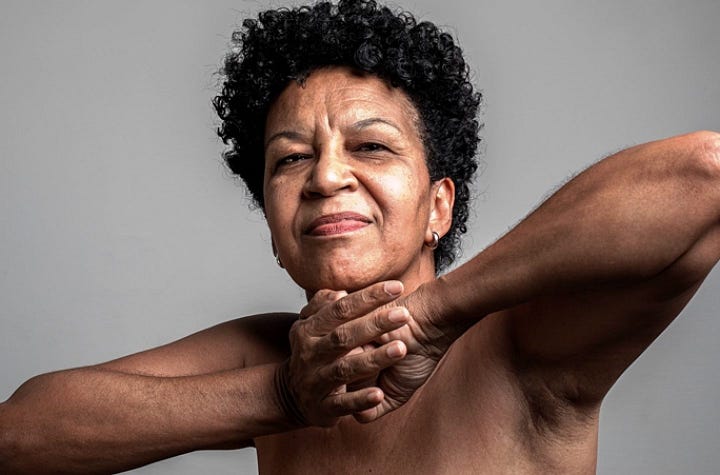

On a track like “Canto II,” which you can check out below, there’s no missing the singer’s deep roots in Brazilian tradition, which extends well beyond samba. Her throaty, soulful presence remains elegant and strong in the face of stark synthetic gurgles, oversaturated electronic noise, and reverb-soaked metallic percussion. Marçal is the kind of singer that finds melody and tenderness in the most unexpected places, although she can also throw the hammer down, something she routinely does in Méta Méta, her hard-hitting band she co-leads with Dinucci and Thiago França. The festival runs through November 24, with a variety of online discussions and live performances, including a rare visit by New York turntablist Maria Chavez with Chilean artist Nicole L’Huillier on the closing day at Morphine Raum. Full details at the festival website.
Miscellany
Last week the latest installment of the Best Contemporary Classical Music column was published over at Bandcamp Daily, with bracing sounds from the likes of Alvin Lucier, Lucia Dlugoszewski, Polwechsel, George Lewis, Anna Korsun, and Jessica Pavone, among others. And tomorrow, November 14, this month’s edition of Nowhere Street radio will air at 4 PM on Colaboradio here in Berlin at 88.4 FM or online at Freie Radios – Berlin Brandenburg. If you miss it you can catch up with the new episode and all of the old ones at the KM28 mixcloud page.
Recommended Shows in Berlin This Week
November 14: Clara de Asís performs Disappearance of for synthesizer and objects, 8 PM, KM28, Karl-Marx-Straße 28, 12043 Berlin
November 15: Jockstrap, 8 PM, Säälchen, Holzmarktstr. 25, 10243 Berlin
November 15: Karen Lorenz & Nikolaus Schlierf play Walter Zimmermann, 8 PM, Klangwerkstatt—Berlin Festival for New Music, Bethanien Art Quarter, Studio 1, Mariannenpl. 2, 10997 Berlin
November 15: Foster/Jenkins/Eubanks Trio, 8:30 PM, Morphine Raum, Morphine Raum, Köpenicker Straße 147, 10997 Berlin (Hinterhof 1. Etage)
November 16: Dave Rempis & gabby fluke-mogul, 8 PM, KM28, Karl-Marx-Straße 28, 12043 Berlin
November 16: Moritz von Oswald, 8:30 PM, St. Thomas Kirche, Mariannenpl. 28, 10997 Berlin
November 17: Handcrafted Tributes Festival with Stefan Schultze Large Ensemble with Max Loderbauer (synthesizer); Michael Vorfeld (light bulbs & electronic devices) and Elena Kakaliagou (horn), 7 PM, Studioboerne45, Börnestraße 45, 13086 Berlin
November 18: Choir Kwajr & Michael Moore, 7 PM, Theater im Delphi, Gustav-Adolf-Straße 21, 3086 Berlin
November 18: Jules Reidy; Liz Kosack, 8 PM, KM28, Karl-Marx-Straße 28, 12043 Berlin
November 18: Handcrafted Tributes Festival with Rabih Beaini (electronics); Richard Scott (synthesizer), Els Vanderweyer (vibraphone) & Stefan Schultze (piano); Florian Zwißler (electronic organ) & Oxana Omelchuck (synthesizer), 7 PM, Studioboerne45, Börnestraße 45, 13086 Berlin
November 18: Laura Misch, Kantine am Berghain, Am Wriezener Bahnhof, 10243 Berlin
November 19: Radical Sounds Latin America Festival w/ Juçara Marçal & Cadu Tenoria, Les Retournéex, Camila Nebbia, Marcioz, and Gibrana Cervantes, 6 PM, Arkaoda, Karl-Marx Platz 16, 12043 Berlin

